The New York Times could be worth $19 billion instead of $2 billion
Recent annual reports and estimates for the calendar year 2014 suggest interesting comparisons between the financial performance of media (either legacy or digital) and internet giants.
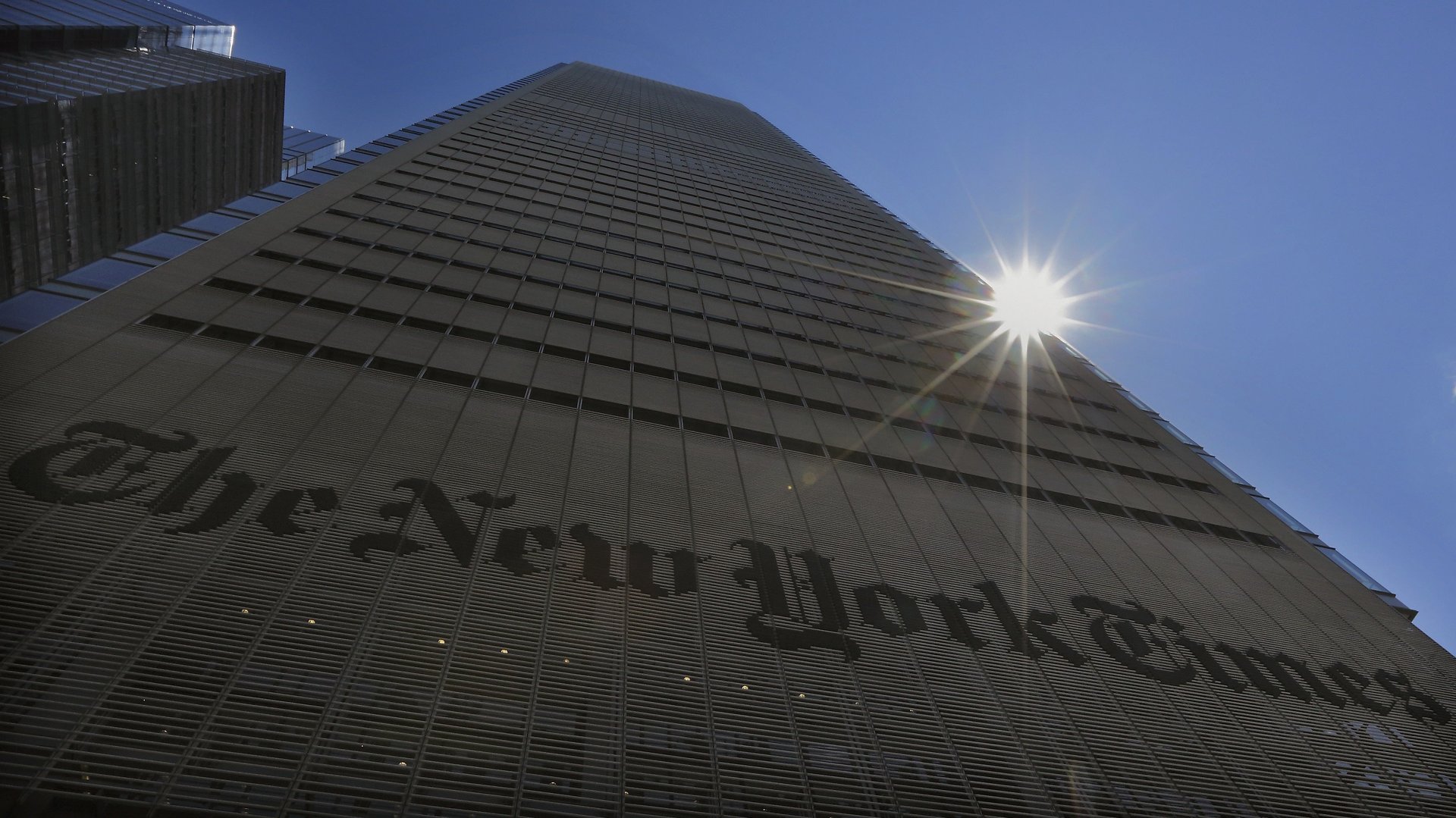

Recent annual reports and estimates for the calendar year 2014 suggest interesting comparisons between the financial performance of media (either legacy or digital) and internet giants.
In the charts below, I look at seven companies, each in a class by itself:
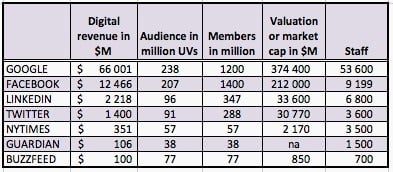
A few explanations are required.
For two companies, in order to make comparisons relevant, I broke down “digital revenues” as they appear in financial statements: $351 million for the New York Times ($182 million in digital advertising + $169 million for digital subscriptions) and, for the Guardian, $106 million (the equivalent of the £69.5 million in the Guardian Media Group annual report [PDF here]).
Audience numbers above come from ComScore (Dec 2014 report) for a common reference. Note that traffic data does vary when looking at other sources—which shows the urgent need for an industry-wide measurement standard.
The “Members” column seemed necessary because traffic as measured by monthly uniques does differ from actual membership. This difference doesn’t apply to news media (NYT, Guardian, BuzzFeed).
For valuations, stock data provide precise market cap figures—but I didn’t venture putting a number on the Guardian’s value. For BuzzFeed, the $850 million figure is based on its latest round of investment. I selected BuzzFeed because it might be one of the most interesting properties to watch this year: It built a huge audience of 77 million unique visitors (some say the number could be over 100 million), mostly by milking endless stacks of listicles, with clever marketing and an abundance of native ads. And, at the same time, BuzzFeed is poaching a number of first-class editors and writers—including, recently, from the Guardian and ProPublica; it will be interesting to see how Buzzfeed uses this talent pool. (For the record: If founder Jonah Peretti and editor-in-chief Ben Smith pull this off, I will gladly revise my harsh opinion of BuzzFeed).
The New York Times is an obvious choice: It belongs to the tiny guild of legacy media that did almost everything right for their conversion to digital. The $169 million revenue coming from its 910,000 digital subscribers didn’t exist at all seven years ago, and digital advertising is now picking up thanks to a decisive shift to native formats. Amazingly enough, the New York Times sales team is said to now feature a ratio of one-to-one between hardcore sales persons and creative people who engineer bespoke campaigns for advertisers. Altogether, last year’s $351 million in digital revenue far surpasses newsroom costs (about $200 million).
A “normal” board of directors would certainly ask management why it does not consider a drastic downsizing of newspaper operations and only keep the fat weekend edition. (I believe the Times will eventually go there.)
The Guardian also deserves to be in this group: It became a global and digital powerhouse that never yielded to the click-bait temptation. From its journalistic breadth and depth to the design of its web site and applications, it is the gold standard of the profession—but regrettably not for its financial performances—read Henry Mance’s piece in the Financial Times.
Coming back to our analysis, Google unsurprisingly crushes all competitors when it comes to its financial performance against its audience (counted in monthly unique visitors):

Google monetizes its UVs (unique visitors) almost five times better than its archrival Facebook, and 46 times better than The New York Times Digital. BuzzFeed generates a tiny $1.30 per unique visitor per year.
When measured in terms of membership—which doesn’t apply to digital media—the gap is even greater between the search engine and the rest of the pack :
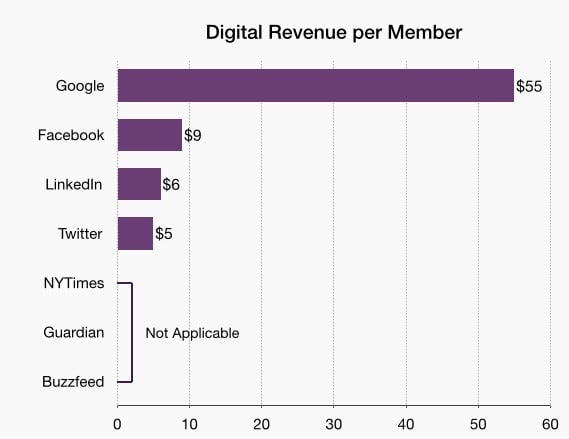
The valuation approach reveals an apparent break in financial logic
While being a giant in every aspect (revenue, profit, market share, R&D spending, staffing, etc), Google appears strangely undervalued. When you divide its market capitalization by its actual revenue, the multiple is not even six times the revenue. By comparison, BuzzFeed has a multiple of 8.5 times its presumed revenue (the multiple could fall below six if its audience remains the same and its projected revenue increases by 50% this year, as management suggests). Conversely, when using this market cap/revenue metric, the top three (Twitter, Facebook, and even LinkedIn) show strong signs of overvaluation:
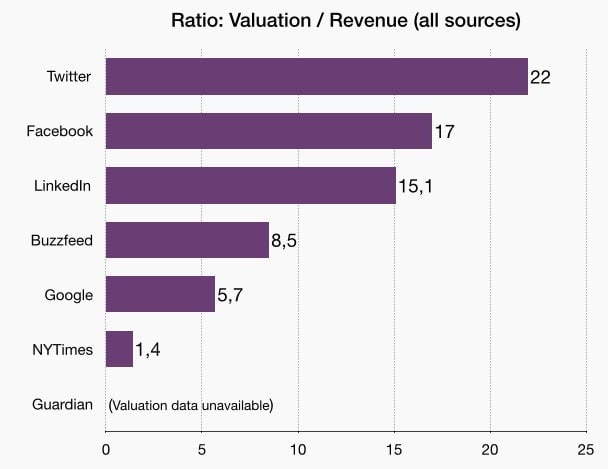
Through this lens, if Wall Street could assign to the New York Times the ratio Silicon Valley grants BuzzFeed (8.5 instead of a paltry 1.4), the Times would be worth about $19 billion instead of the current $2.2 billion.
Again, there is no doubt that Wall Street would respond enthusiastically to a major shrinkage of NYTCo’s print operations; but regardless of the drag caused by the newspaper itself, the valuation gap is absurdly wide when considering that 75% of BuzzFeed traffic is actually controlled by Facebook, certainly not the most reliably unselfish partner.
As if the above wasn’t enough, a final look confirms the oddity of market valuations. Riding the unabated trust of its investors, BuzzFeed brings three times less money per employee than the New York Times does (all sources of revenue included this time):
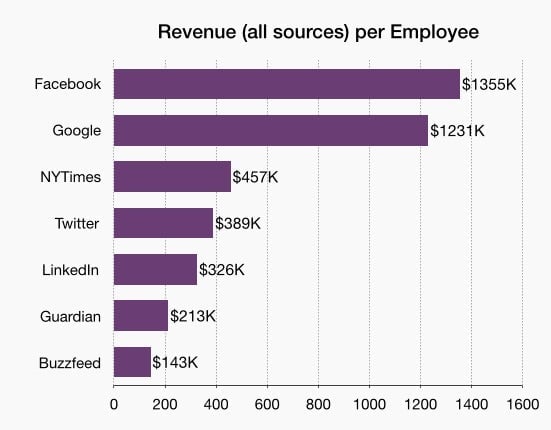
I leave it to the reader to decide whether this is a bubble that rewards hype and clever marketing, or if the New York Times is an unsung investment opportunity.
You can read more of Monday Note’s coverage of technology and media here.